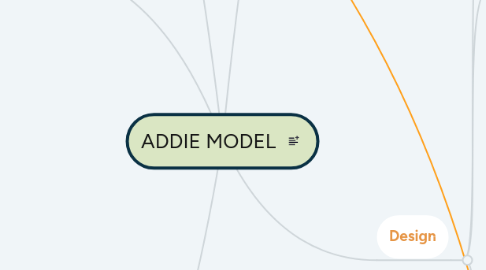
1. Implementation
1.1. Train the instructor in
1.1.1. objectives
1.1.2. Activities
1.1.3. Media
1.1.4. Assessments
1.2. Prepare the learners
1.2.1. Pre-requesites
1.2.2. Orientation
1.2.3. Learning management software
1.3. Arrange the learning space
1.3.1. Have the materials ready
1.3.2. Test multimedia
1.3.3. Technology
2. Development
2.1. Create a sample instruction
2.2. Develop course materials
2.2.1. based on
2.2.1.1. Sample instruction
2.2.1.2. instructional strategy
2.3. Conduct a run-through
2.3.1. Time
2.3.2. Feedback
2.4. real-time rehearsal
3. Evaluation
3.1. Formative
3.1.1. One-to-one test with learners
3.1.2. Small group test
3.1.3. Field trial
3.1.3.1. Real-time rehearsal
3.1.3.2. Setting should be similar to actual learning scenario
3.2. Summative
3.2.1. Reactions
3.2.1.1. to
3.2.1.1.1. Instructors
3.2.1.1.2. Media
3.2.1.1.3. Activities
3.2.1.1.4. etc
3.2.1.2. using
3.2.1.2.1. scales
3.2.1.2.2. open-ended questions
3.2.1.2.3. Anonymous
3.2.2. Learning
3.2.2.1. Post-test
3.2.2.1.1. knowledge
3.2.2.1.2. skills
3.2.2.1.3. attitudes
3.2.2.2. Behaviour (real-life)
3.2.2.3. Results
3.2.2.3.1. Increase in profit
3.2.2.3.2. increase in productivity
3.2.2.3.3. morale
3.2.2.3.4. job satisfaction
3.2.2.3.5. others
4. Analysis
4.1. Instructional Goals
4.1.1. Define the overall learning outcome you want to achieve
4.2. Instructional Analysis
4.2.1. Describe all the necessary steps to achieve the overall learning outcomes
4.3. Learner Analysis
4.3.1. Describe what they already know about the subject
4.3.2. Analyze the depth of learning needed
4.3.3. Analyze how and in what context are they going to apply what they learned
4.4. Learning Objectives
4.4.1. Describe what students should be able to do when the instruction is completed in
4.4.1.1. Knowledge
4.4.1.2. Skills
4.4.1.3. Attitudes
4.4.2. "by the time the student finishes this course, he should be able to ______________"
5. Design
5.1. Design Assessments
5.1.1. based on
5.1.1.1. Learning objectives
5.1.1.2. Learner analysis
5.2. Choose a course format
5.2.1. Classroom
5.2.2. Labs
5.2.3. Videos
5.2.4. Interactive through computer
5.2.5. Blended
5.3. Create an instructional strategy using
5.3.1. Tools
5.3.1.1. Lectures
5.3.1.2. Readings
5.3.1.3. Discussions
5.3.1.4. Projects
5.3.1.5. Worksheets
5.3.1.6. Activities
5.3.1.7. Assessments
5.3.2. Dick and Carey's Components
5.3.2.1. Preinstructional activities
5.3.2.1.1. Motivate
5.3.2.1.2. Ilustrate course objectives
5.3.2.2. Content presentation
5.3.2.2.1. Concise
5.3.2.2.2. Use examples
5.3.2.3. Learner participation
5.3.2.3.1. Practice
5.3.2.3.2. Feedback
5.3.2.4. Assessment
5.3.2.4.1. Practice assessments
5.3.2.4.2. Attitudes assessments
5.3.2.4.3. Final Assessment
5.3.2.5. Follow-through activities
5.3.2.5.1. Reviews of the content
5.3.2.5.2. Helps internalize and apply
